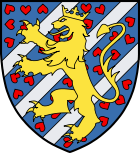- House of Bjelbo
-
Swedish Royalty
House of BjelboValdemar Parents Birger Jarl, Ingeborg Children Prince Eric, Princess Ingeborg, Prince Eric, Princess Marina, Princess Rikissa, Princess Catherine, Princess Margaret Magnus III Children Princess Ingeborg, Birger, Prince Eric, Prince Valdemar, Princess Rikissa Birger Children Prince Magnus, Prince Eric, Princess Agnes, Princess Catherine Magnus IV Children Eric XII, Haakon VI Eric XII Haakon VI Children King Olav IV The House of Bjelbo (Swedish: Bjälboätten), also known as the House of Folkung (Folkungaätten), was an Ostrogothian Swedish family that provided for several medieval Swedish bishops, jarls and kings.[1]
Contents
Name and origin
The house has been known as the "House of Folkung" since the 17th century, and this name is still the most commonly used in Swedish works of reference. This name is probably derived from the oldest known member of the family who is certain to have existed, i.e. Folke who lived about the year 1100, or their legendary forefather Folke Filbyter who lived in pagan times.[2] In an effort to avoid confusion with the Folkunge Party some modern historians have argued that "House of Bjälbo" would be a better name because Birger Jarl lived there and it is the family's oldest known manor. Bjälbo is located in Östergötland, outside of Skänninge in the present-day commune of Mjölby. In any way the members of this dynasty never used a name to refer to themselves since family names were not widely adopted in Sweden until the 16th century, thus there is no "correct name" of the dynasty which would have precedence over the other. [3]
Jarls and bishops
The House of Bjelbo produced most of the jarls in Sweden in the 11th, 12th and 13th centuries until the title was abolished in 1266. Different branches of the family were often rivals for the office of jarl. Most of the kings during that time were also from Östergötland.
Around 1100, Folke the Fat became the first known Bjelbo jarl, and probably the first jarl of all Sweden, under king Inge I of Sweden. He was married to a daughter of king Canute IV of Denmark. According to legends, he was the first of his family so elevated. Nothing is known of any of Folke's collateral relatives, though it is well-established that several of his sons' descendants were important lords.
Other notable jarls from the family were Birger Brosa, Charles the Deaf, Ulf Fase, and Birger jarl. In the early 13th century, some members of the family moved to Norway, and held the office of jarl there. Noteworthy is that regardless of the ruling royal family, Bjelbos continued to hold the position of the jarl in the kingdom.
Several members of the family were also Bishops of Linköping at least in the 13th century. Diocese covered the area of Östergötland. Bishop of Linköping was often involved in the eastern activities.
Rise to royalty
Valdemar, a son of Birger jarl, was elected as the King of Sweden in 1250. House of Bjelbo had gradually married to all rival royal dynasties in Sweden eventually producing an heir related to them all. When the previous king Eric had died without an heir apparent, his sister's son, and also Birger's son, was the most suitable option to hold the royal office.
The male line reigned in Sweden until 1364. From 1319 to 1387, the members of the family were also kings in Norway. Almost all subsequent monarchs of Sweden, Norway and Denmark descend from the House of Bjelbo through female lines.
Unclarities in genealogy
Particularly, several persons conventionally assigned as sons and grandsons to Benedict Snivel, son of Folke the Fat, may actually be related to him in a different way. Conventional assignations stretch two generations to cover a hundred years, which is probably not realistic, and three generations over 150 years.
See also
Sources
This article is fully or partially based on material from Nordisk familjebok (1908).
Other sources
- Lindkvist, Thomas with Maria Sjöberg (2006) Det svenska samhället 800-1720. Klerkernas och adelns tid, Andra upplagan (Lund: Studentlitteratur) ISBN 91-44-01181-4
- Starbäck, Georg; P.O. Bäckström (1885–1886) Berättelser ur svenska historien (Stockholm: F. & G. Beijers Förlag)
References
House of BjelboPreceded by
House of EricRuling House of the Kingdom of Sweden
1250–1364Succeeded by
House of MecklenburgCategories:- History of Sweden
- History of Norway
- Norwegian monarchy
- Royal families of Sweden
- 12th century in Sweden
- 13th century in Sweden
Wikimedia Foundation. 2010.

